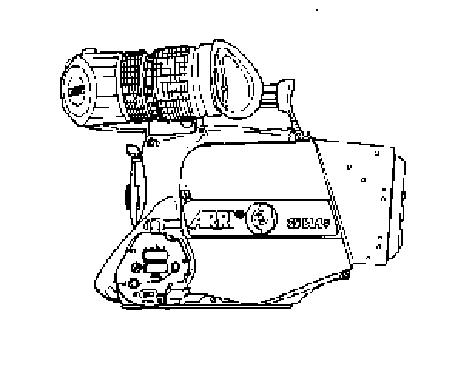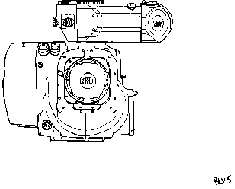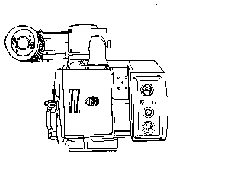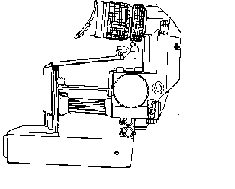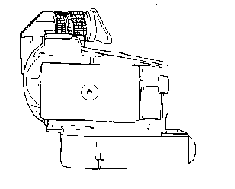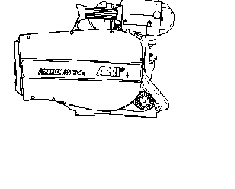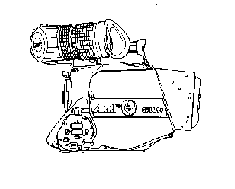Arriflex 35 Book
3rd Edition from Focal Press
Excerpts:
35 BL Camera Views
|
|
|
|
|
|
|
|
|
Comparison chart of 35BL Cameras
35BL Technical Specs
| CAMERA | shutter angles (in degrees) |
normal frame rate & w/ ext. control |
temp range | wght. w/ 400' mag no lens, no film |
| 35BL-4s | 180, 172.8, 144 | 24, 25, 30 6 - 40 |
-20° to +50°
C -4° to +122° F |
14.5kg 31.9 lbs |
| 35BL-4 | 180, 172.8, 144 | 24, 25 - 6-40 |
20° to +50°
C -4° to +122° F |
14 kg 30.9 lbs |
| 35BL-3 | 180, 172.8, 144 | 24, 25 6-42 |
-20° to +50°
C -4° to +122° F |
13 kg 28½ lbs |
| 35BL-2 | 180 | 24, 25 5 - 50 |
-25° to +55° C | 12.5 kg 28 lbs |
| 35BL-1 | 180 | 24, 25 5 - 100 |
12.5 kg 28 lbs |
Industry standard dual pin registration:
Two double pronged pull-down claws on early 35BL-1 cameras for high speed to 100
fps with special magazine roller arms.
Two single prong pull-down claws on all other 35BL cameras.
viewfinder magnification on all: 6.5x
supply voltage: 12 vdc
battery type: 12v / 7aH
dimensions of 35BL-4s, and 35BL4:
with 400' (120m) mag: L 17.3", W 12", H 9.1"
(L 440, W 305, H 230 mm)
with 1000' (300m) mag L 21.5", W 12", H 12.5"
(L 546, W 305, H 317 mm)
Dimensions of 35BL-1, 2 and 3:
same length and height. Width is 11" (280mm)
(excerpts from the Introduction)
There are some notable differences between this book and its predecessors. The 16SR Book tried to be as all-encompassing as possible. To avoid leaving anything out, I had to assume (even at the risk of offense) that the reader had suddenly decided on a massive career change into camera assisting after twenty years of exile to the remotest regions of Ruwundi as the chiropractor on an archeological dig.
The ARRI 35 Book, in an attempt to avoid repetition but more importantly to
continue sales of the ever-popular 16SR Book, assumes that you have already read
that definitive tome, or have a basic understanding of camera theory and production
protocol.
The ARRI 35 Book is not intended for camera assistants alone. It will hopefully
prove useful to anyone who encounters ARRI 35BL and 35-3 Motion Picture Cameras during the
course of production: from camera package ordering to transport, from shipping to
shooting, and from rental to repair.
This book does not intend to be a comprehensive compendium of all ARRI 35 cameras. It
is, instead, my highly personal view of a practical system of currently
manufactured ARRI cameras and accessories that I find helpful in my work as a cameraman.
To qualify the approach taken in this book, I consider that the ARRI 35 System
"took off" with the 35BL-3, which eliminated the infamous lens blimp and
introduced the PL lens mount. By the time the 35BL-4 was introduced, the camera bore very
little resemblance to original models except for its external shape, coaxial magazine
concept and accessory compatibility. Many improvements made by ARRI were designed so they
could also be retrofitted to earlier models. The PL lens mount afforded a wider range of
new and faster lenses. Finally, the complementary 35-3 and 35-3C cameras were made a part
of the system with shared accessories, along with 35-2C "hard-front"
conversions.
For the Director of Photography
The ARRI 35 Book comes out of my experience as a cameraman who owned and used
35BL and 35-3 cameras for some time. We have spent much time together: in customs offices
around the world, held hostage in South America, basking on beaches and baking in deserts
where the camera got too hot to hold, and on Arctic glaciers so cold that bare skin froze
to bare metal. Certainly most Directors of Photography have put in similar time in similar
situations.
I sometimes think that Directors of Photography are somewhat like master chefs; they have to be creative, efficient, and inventive. They also have to know the tools of their trade.
If they forget that the skillet gets hot, they'll get burned.
So here's a collection of advice and techniques gleaned from camera crews, technicians,
production people, suppliers, colleagues, friends and manufacturers around the world: a
veritable global intensive burn-prevention unit.
This book provides an overview of the Arriflex 35mm system. It details what's available
for special tasks, what can be done, and what can't. It provides technical support and
reference that have taken many years of on-the-job experience to obtain.
For the Camera Operator
There are certain tricks of the trade as well as special equipment that can
expedite the relationship of camera operator to camera. This book summarizes many ideas
and procedures, which do not intend to be definitive--but are offered as suggestions.
Equipment which I find helpful in executing difficult shots or making easy shots even
easier are detailed here.
For the Camera Assistant
There isn't very much documentation on the ARRI 35BL and 35-3 system. And there are
numerous ways to get the job done. Here are our suggestions, based on the advice of the
camera assistants (some now cameramen) who have worked with me for the past five years:
Jon Ercole, Gabor Kover, Phil Abraham, and Mike Barry. Some of the procedures mentioned in
this book outline emergency field repairs. These are for very advanced assistants. Don't
attempt them if you are not confident. There is nothing worse than causing thousands of
dollars of damage because of a bungled repair job. Don't be ashamed to admit what you
don't know.
But, if you're shooting in the jungles of New Guinea and Percolator Courier can't
absolutely, positively get your last working 400' magazine back to ARRI within the next
millenium, then you might be tempted to attempt a complicated procedure described here, if
you haven't already used those pages to fabricate the covering for a raft on which to
escape.
For the Rental House
Rental houses usually have highly skilled, factory-trained technicians who
maintain and service the cameras. However, there is always a need to train new people for
this important task. Some of the more common camera service protocols are detailed here,
to serve as a consolidated reference source. These procedures--such as adjusting magazine
tension and timing, lubricating, checking depth and lenses--should also prove informative
to the technically advanced camera assistant.
For Film Students
The traditional method of learning about cameras was to hang out at a rental house
in the hopes of picking up practical insights while trying to stay out of everyone's way.
Fortunately, workshops and training seminars are now available, and this text should
supplement hands-on experience.
For the Producer
This book should also be useful to the production community in ordering equipment,
budgeting and bidding jobs, and acquainting themselves with the camera system and
accessories. Knowing who makes rain deflectors, for example, or where to get a rocker
plate, can help the production office in whose lap the cameraman has just dumped a large
and esoteric last minute request. Camera equipment lists have been included to aid in
putting together and ordering a camera package.
Retrofit Syndrome
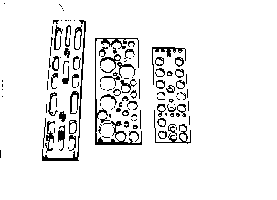
Many camera people seem to be afflicted with a malady known as Retrofit Syndrome. The
manifestation is first observed when a perfectly new and seemingly fine piece of
electro-optical machinery is immediately checked, measured, drilled and modified upon
acquisition.
It's not a new phenomenon. Along with the new cameras I use professionally, I collect
antique wooden hand-cranked cameras. Some of them date back to 1903. But I don't think I
have a single antique or modern camera that hasn't been drilled, cut, grooved, notched,
tapped, taped, or tampered with by someone. The retrofits include external sport finders,
carrying handles, top mounted tripod threads, single framing gears, and filter
holders--satisfying the same requirements as today.
Camera manufacturers are often appalled by our apparent discontent with their
out-of-the-box products. Quite the contrary, they should rest easy in the knowledge that
their products are being lavished with meticulous care, at great expense, upon electronic
benches and in machine shops everywhere. Probably the demons responsible for Retrofit
Syndrome are the same demons that drive camera people toward individual styles and forms
of expression. Ask ten cinematographers to describe their style of shooting, and ten
totally different opinions will emerge. Ask a dozen camera assistants to lay out a perfect
camera body case, and a dozen different cases will be designed. Take the different styles,
configure cameras to accommodate those styles, pack the dozen cameras in the ten cases,
multiply by several thousand, and the opportunity for modification certainly seems almost
comforting.
Cinematography is exciting because it provides opportunities for developing individual
approaches in effectively transforming ideas into images, using technology customized to
the task. But when technology catches up, and in turn becomes the force that shapes
technique in the absense of content, it is once again time for the cycle to continue with
a massive relapse of retrofit-syndrome.
35BL Camera Model Evolution
The Arriflex 35BL design was conceived in 1966 as the first portable, dual pin
registered, hand-held, silent reflex motion picture camera. Its first significant
production use was at the 1972 Olympic Games, where it was employed for sync-sound,
cinéma vérité and slow motion filming at speeds to 100 fps. At the same time, its
theatrical and television use began with a large commitment by Cinemobile for location
work.
The camera evolved. The analog footage and frame rate indicators of the 35BL-1 were
replaced by a digital read-out on the 35BL-2. With the 35BL-3, the lens blimp was
eliminated. Early BL models were equipped with an ARRI 41mm bayonet mount, which was soon
replaced by the larger 54mm diameter PL lens mount. The 35BL-4 introduced a brighter
eyepiece and illuminated groundglass. The 35BL-4s came out with a new, quieter,
adjustable-pitch multi-link compensating movement, new footage/meters counter, redesigned
internal construction, and magazines with an external timing adjustment.
When shipping the 35BL, be sure movement is closed and the magazine opening cover is in place!
Camera Care and Cleaning
(excerpt from ARRI 35 Book)
Although I had long held my own intractable opinions on what chemicals and camera
cleaning techniques should be used where, when and how, I thought it prudent while
preparing this book to talk with as many rental houses, manufacturers, service technicians
and camera assistants as possible. Interestingly, the number of people interviewed equaled
the number of disparate and intractable opinions heard. There was absolutely no consensus.
To find out if indeed there might be some merit to these techniques, we decided to
conduct the 1988 Camera Cleaning Olympics. The events were mostly held on the job and on
location in between shots by Jonathan Ercole, Jason Berry, and as many volunteers as we
could ensnare.
The events were held in a strictly controlled and scientific environment modeled after
the unbiased Consumer Reports Testing Laboratory, and closely resembling actual film
industry conditions.
Contestants in the Camera Cleaning Olympics first had to consume a standard messy
location breakfast without the aid of utensils or napkins of any kind. East Coast stale
bagels smeared with cream cheese were followed by the obligatory West Coast breakfast
burrito. After an oozing fruit Danish, contestants were required to stir powdered cream
and sugar into tepid coffee with their thumbs.
Now the games could begin. The contestants were required to handle cameras, lenses,
magazines and filters with their gooey fingers. Then they had to clean everything with a
wide selection of lens-cleaning fluids, solvents, lens-tissues, blowers, air cans and
tools.
The recommendations below represent the winners of our tests. Please remember that the tests apply to service and cleaning in the field, not in a shop or rental house. While shops might be concerned about constant adequate ventilation and fire hazards, we chose the products that seemed to work best, fastest, with the least possibility of damage to paint, lens coatings, camera body and human body.
Cleaning Lenses and Eyepiece
Less is more. Don't clean more than necessary. First try a puff of air, then a
lens brush. Fingerprints, grease or smudges must be removed with a solvent.
Pro-Phot impregnated cloths came in first in our
Camera Care Olympics, with a score of 10 out of 10. Made in France by JOB, each
pre-moistened cloth is sealed in an individual packet, and a package of 12 comes with a
plastic stick, slit at one end to hold the swabs for hard-to-reach places. As this goes to
press, I can't locate an official US distributor, but some photo dealers stock Pro-Phot.
Panchro Mirror Cleaner on a moistened lens
tissue or Kimwipe is our second choice for lenses, first choice for large filters. Apply
one drop of the fluid to the tissue, not directly to the lens. Otherwise, the fluid might
seep into the lens itself around the edges of the element being cleaned. Wipe gently in a
circular motion. Do not scrub. Do not use dry tissues. They should always be moist.
The optical element of the eyepiece closest to your eye is coated with a soft coating.
This is especially true of ARRI's wide angle eyepiece which has a high light transmission
index, and hence a higher sensitivity to abrasion. Sweat can damage and eat away at the
coating. Scrubbing with a dry lens tissue will scratch the coating. So always use a
moistened tissue here. Pro-Phot Wipes and Panchro Mirror Fluid scored 3 points higher than
any other cleaner, all of which smeared and streaked to varying degrees.
Mirror Shutter and Groundglass
These should not be cleaned unless badly smudged. Use Pro-Phot or Panchro Mirror
Cleaner applied with Kimwipes. Do not use lens tissue on the mirror shutter, because some
lens tissues are slightly abrasive. The mirror shutter is coated with aluminum and is
softer than most lens coatings. Many 35BL-4 groundglasses are etched with a fluorescent
paint that can be dissolved by most solvents, so be extremely careful on the rough side of
the groundglass. Use the solvent sparingly, and only if the glass is badly smudged.
PL Mount, Film Gate, Rods
Metal parts that get sticky or greasy can be cleaned with Lighter fluid. This is widely
available, and comes in handy, usually leakproof containers that easily fit in an
assistant's kit. Kimwipes or cotton rags are essential. Lighter fluid is actually refined
naptha, which, if available, is better because it is pure. Some lighter fluids contain
greasy additives that smudge more than clean. Ronson and Zippo lighter fluids seem
"dry" and free of impurities.
Lighter fluid is flammable. Be careful. Don't smoke
while using it. Don't use Handwarmer fluids or white gas.Some repair shops
use Trichloroethane. This is an excellent, non-flammable solvent. It is a better
de-greaser than naptha. However, care must be taken because it can remove paint. Note
especially that the leading and trailing edges of the mirror shutter are painted with an
anti-reflective black paint. Do not clean this off. Also be careful using Trichloroethane.
You must use it in a well-ventilated area. Otherwise, it is harmful to your health.
Some rental houses use acetone, Shell BT-67, WD-40, or CRC-556. Acetone is an excellent
de-greaser, but also an excellent paint remover. In the field it is all too easy to remove
an anti-reflective black coating. Cleaner-lubricants such as WD-40 and CRC-556 are
slightly oily and sticky. They tend to attract dirt and dust, which then works its way
into the mechanism, making more frequent cleaning necessary. I think that drier is better,
especially on lens rods and lens mounts. The exception is a humid, wet environment, in
which case I recommend CRC-556 (or CRC-336), which displaces moisture, prevents rust, and
is not too oily or sticky.
Silicone
The only place to use silicone is on rubber gaskets ("O" rings) in the lids
of camera cases, underwater housings and Scuba equipment. Never use silicone on the
"O" rings of magazines. It's a good lubricant, but because it's so good, it
"migrates" to other pieces of equipment and is almost impossible to remove. I
don't know of any solvent to get silicone off lens elements, where it will surely smudge.
Use wisely and sparingly.
Cleaning Exterior of Camera, Magazines, etc.
Use Glass-Plus, Windex, and most window cleaners which contain ammonia, alcohol,
detergent and water. Again, in hot, wet, humid environments, I recommend CRC-556 or
CRC-336. Apply it first to a cotton rag. Then rub on camera. Let it sit for a few minutes.
Then wipe dry with a clean rag. Keep the CRC away from lens and optical surfaces.
On the threads of eyepiece, eyepiece extender, and
things that screw in: Lighter fluid. In sticky places, CRC-556.
Cleaning Cases
On fibreglass-covered cases, use industrial cleaners such as Armorall, Pine Power and
even acetone on particularly stubborn labels. Use Graffitti Remover for paint or shipper's
markings. On aluminum cases, such as Halliburton and Samcine Rigidised Cases, WD-40 works
best. Let it soak into the stubborn label adhesives. Wipe dry. Use Scotchbrite green
scouring pads to buff surfaces. You can automate this process by using Scotchbrite on the
buffing wheel of a drill.
Do not use acetone on plastic-covered, PVC, or Thermodyne cases unless you test it
first. Acetone may eat the case.
Air
Falcon Safety Products, Inc. has recently introduced an environmentally safe canned
cleaning gas without chlorofluorocarbons (CFC). Falcon's Dust-Off Plus contains
hydrochlorofluorocarbons (HCFC) which purportedly do not deplete the earth's ozone layer.
Other manufacturers will hopefully follow. Earlier versions of the product, Dust-Off,
Dust-Off II, and other brands containing CFC, are harmful. Read the label.
Be careful when using canned gas. It can leave a residue on mirror shutters and lenses.
Certain areas of the movement should be avoided, because you might blow oil or grease all
over the place. Another danger is blowing dirt further into the camera mechanism. Try to
clean so the air blows away from camera cavities.
The Hurricane Jumbo Air Syringe is highly recommended. It never runs out, won't leave a
residue, and won't spew out anything other than air.
Air compressors are great, especially on features, long jobs, in rental houses and
repair departments. Small portable ones are increasingly available. Some run off 12
volts--useful with car batteries and even camera batteries. Nitrogen tanks, available from
welding supply companies, are also popular. Nitrogen is dryer than compressed air, and
therefore preferable. You need to obtain a regulator, air hoze and nozzle. Often these can
be rented from the welding supplier. These tanks also come in small sizes.
Bottles and Boxes

To carry your solvents, small Nalgene bottles are available from most outdoor retailers (REI, Eastern Mountain Sports.) They are leakproof and solvent resistant, even to acetone. Test first, however, before shipping. It's a good idea to store your solvents and lubricants in waterproof, "O" Ring lidded containers. These are also sold by outdoor retailers. I like Japanese Sushi lunchboxes because they usually have clear plastic see-through lids.
Swabs and Q-Tips
The best swabs don't shed lint, and are made of foam. They are available from Markertek
and other video and computer supply companies. The Flextip and Foamtip are useful, while
the Flextip Mini is good for small areas. Long wooden-handled cotton swabs are less
expensive. Wrapping the cotton end with lens tissue or Kimwipes provides a lint-free
cleaning surface. Readily available at most drug stores are Q-Tips Manicure Sticks, which
have a pointed, relatively lint-free cotton point on one end and a pointed wooden stick on
the other end for probing and scraping. Remember to watch out for lint in delicate areas
such as bearings, the movement area, screw threads, and so on.
Lubricants
To apply PDP-38 oil, you will need a syringe and needle. To apply Petrolon to
movements, you need a syringe with a wide diameter needle. The needles should be dulled by
filing the ends so you don't scratch the metal or stick yourself. These medical supplies
are not easily obtained. Perhaps your doctor will oblige.
Tools
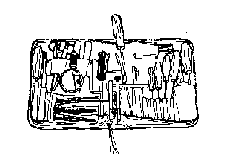
Tools for field repairs can usually fit into a soft-sided pouch, which can be stuffed
in any convenient case or bag.
I recommend the Black Magic Sr. 12½" x 10" x 2½" Pouch from Jensen
Tools Inc. of Phoenix, Arizona.
If you have secret dreams of being an executive or a mercenary, you can purchase one of
the many high-tech hard-bodied tool cases with tool pallets from Jensen Tools Inc. Some
are cleverly disguised as Halliburton-style executive attachés, and others come in
waterproof mil-spec olive drab ABS with black anti-reflective annodized latches.
Screwdrivers
I highly recommend the ARRI #1, #2 and #3 screwdrivers. They fit the tight screws of
magazines perfectly. Because they are not tapered, but ground straight, they will not burr
the heads of these screws.
If you have a grinding wheel, you can straighten the taper of standard screwdrivers.
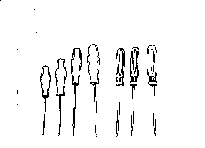 Screwdrivers from
ARRI (part number):
Screwdrivers from
ARRI (part number):
- #1 .5 x 3.5 mm (K5.26139.0)
- #2 .6 x 4 mm (K5.26140.0)
- #3 .9 x 5 mm (K5.26141.0)
- #4 1.0 x 6 mm (K5.26142.0)
Screwdrivers from ARRI or Metric Tools Co: - .4 x 2.5 x 75 mm
- .5 x 3.0 x 75 mm
- Set of Jewelers Screwdrivers
- Set of Hex keys--Metric and Inch
- ARRI SW2 Hex driver for variable shutters (2mm)
- Miniature Needlenose Pliers (1" narrow nose)
- Thin Nose Angled Flush Wire Cutters
- Wire strippers
- Soldering iron
- Small Vise-Grips (4")
- Spanner Wrench Set (Edmund S31,817 or S36,156)
- Scissors
- Tweezers
- Digiprobe Digital Multimeter
- Small Soldering Iron
- Tube of Ersin Multicore Solder 16 Gauge
- Solder Wick Desoldering Spool
- Small pieces of wire
- Set of Xcelite interchangeable screwdriver blades and handle
- Regular slot 1/8", 3/16", 1/4", 5/16"
- Phillips slot #0, #1, #2
- ARRI tension gauge (add 2 feet to existing string)
- ARRI plastic skewer
- ARRI Groundglass puller (Hirschmann Forceps)
- Master Ultratorch 3 (Jensen L10B700) is a compact, butane gas powered soldering tool useful for remote locations. You can also purchase a 12 volt soldering iron from a Marine Supply store, and power it from your car, boat or camera battery.
- A digital multimeter is essential if you are going to have to adjust Microforce
Controls. A $60 "probe meter," not much larger than a cigar, will fit easily
into any tool case.
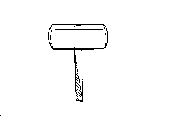
A stubby screwdriver is useful for tightening the 3/8" x 16 tie-down bolt to the camera .
The blade should be wide enough to fully engage the bolt's slot.
Other Recommended Tools
Assistant Outfitting
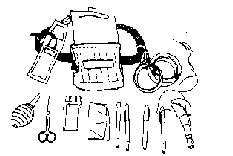
The North Face Belt Pouch with a quick-release belt seems popular.
Contents: Dry marker taped to powder puff for slates, air syringe, pens, pencils, Mini
Maglite, Sanford Sharpie Permanent Markers, Pilot Ultra Fine Point Permanent Markers
(SC-UF) in assorted colors, flashlight, blunt-tipped scissors, lens tissue, and a small
bottle of Panchro Lens Fluid.
Hanging from the belt by a carabiner are usually two rolls of tape: white camera tape
for everything, and black paper tape (1") for mattebox and other areas where blocking
light is necessary. In its own Cordura Pouch is the latest, largest, heaviest Victorinox
Swiss Army Knife, ready to open or tinker with anything that comes in its path.
Eye Cushions
Most rental houses and camera supply houses carry foam or chamois/foam eye cushions to
cover the camera's eyecup. These should be washed or changed as often as you change your
socks. Wash in warm, soapy water, and rinse. You can speed up drying with a hair dryer.
Crumple the chammy in your hand to restore softness. The combination sandwich chamois/foam
eye cushions may come apart when washed.
Front Box
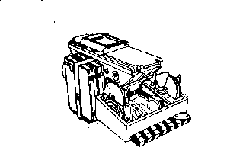
The front box shown here is mounted on an Arrihead, which is also carrying two flat
Cine 60 7aH batteries on its side battery bracket.
Make sure the front box has room for the DP's meters and gum.
If there is any room left over, the front box should accommodate slate, markers, pens,
focus tape measures, Kelly Calculator, Samcine Calculator, lens tissue and fluid.
All these implements will spill out when the dolly is wheeled around outside, which is
why you will also want a Larry Bag, Rapport Bag, L.L. Bean Canvas Bag or some other tote
bag to carry all your paraphernalia with some assurance of later retrieval.
Loading
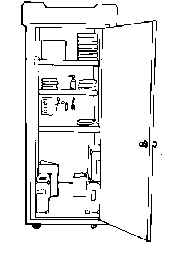
The key to fast and foolproof loading is to organize your darkroom or changing bag routine so it is consistent, foolproof and clean. You will have to prepare a system that will allow you to load different emulsions into different magazines without mixing them up.
A good routine is to work from left to right: keeping all unexposed film on your left
and all exposed film on your right.
Above all, the darkroom must be clean. Any dirt or dust on the shelves is bound to wind
up inside the magazines. Dirt might eventually come to rest on the camera aperture as an
infamous "hair in the gate."
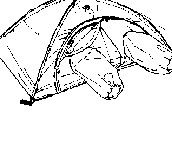 While a darkroom is an invaluable asset, it may
not be practical on location or in the back of a cargo van. The Harrison Film Changing
Tent makes changing more comfortable in hot and humid places by keeping the fabric away
from your hands.
While a darkroom is an invaluable asset, it may
not be practical on location or in the back of a cargo van. The Harrison Film Changing
Tent makes changing more comfortable in hot and humid places by keeping the fabric away
from your hands.
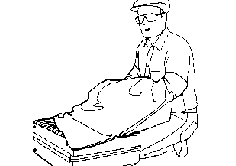 If you're using a traditional changing bag, you
should go with the heavy duty large size 36" x 36" or 36" x 45". Be
sure you get a pouch or nylon stuff-sack for storage.
If you're using a traditional changing bag, you
should go with the heavy duty large size 36" x 36" or 36" x 45". Be
sure you get a pouch or nylon stuff-sack for storage.
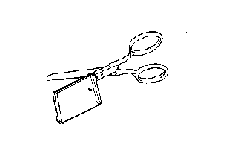
This funny looking tool (ARRI K4.30689.0), which looks like a scissors mated with a
platypus, can be extremely helpful for cutting the leading edge of the film across its
perfs. The locating pin lets you use it in the dark, and the blunt ends of the scissors
should keep you from poking a hole in your changing bag.
Use this film cutting gauge after you have attempted to engage the film onto a sprocket
roller and you think you might have torn or creased the perfs. Most ARRI magazines have
difficulty accepting film not cut across the perfs--especially on short ends.
Be sure you recover any small pieces of film you have cut off, so they don't wind up in the magazine.
